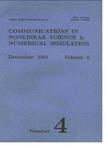版权所有:内蒙古大学图书馆 技术提供:维普资讯• 智图
内蒙古自治区呼和浩特市赛罕区大学西街235号 邮编: 010021

作者机构:Georgia State Univ Petit Sci Ctr Neurosci Inst 100 Piedmont Ave Atlanta GA 30303 USA Georgia State Univ Dept Comp Sci 25 Pk Pl NE Atlanta GA 30303 USA Georgia State Univ Petit Sci Ctr Dept Math & Stat 100 Piedmont Ave Atlanta GA 30303 USA
出 版 物:《COMMUNICATIONS IN NONLINEAR SCIENCE AND NUMERICAL SIMULATION》 (非线性科学和数值模拟快报)
年 卷 期:2020年第83卷
页 面:105139-105139页
核心收录:
学科分类:07[理学] 0701[理学-数学] 0702[理学-物理学] 0801[工学-力学(可授工学、理学学位)] 070101[理学-基础数学]
基 金:NSF [IOS-1455527] RSF at the Lobachevsky University of Nizhny Novgorod [14-41-00044] Georgia State University's Brains and Behavior initiative Molecular Basis of Disease initiative
主 题:Bifurcations Multistability Central pattern generators Unsupervised machine learning Dynamical systems Clustering Poincarereturn maps
摘 要:The co-existence of multistable rhythms generated by oscillatory neural circuits made up of 4 and more cells, their onset, stability conditions, and the transitions between such rhythms are not well understood. This is partly due to the lack of appropriate visual and computational tools. In this study, we employ modern computational approaches including unsupervised machine learning (clustering) algorithms and fast parallel simulations powered by graphics processing units (GPUs) to further extend our previously developed techniques based on the theory of dynamical systems and bifurcations. This allows us to analyze the fundamental principles and mechanisms that ensure the robustness and multifunctionality of such neural circuits. In addition, we examine how network topology affects the dynamics, and the rhythmic patterns transition/bifurcate as network configurations are altered and the intrinsic properties of the cells and the synapses are varied. This study elaborates on a set of inhibitory coupled 4-cell circuits that can exhibit a variety of mono- and multistable rhythms including pacemakers, paired half-centers, traveling-waves, synchronized states, as well as various chimeras. Our detailed analysis is helpful to generate verifiable hypotheses for neurophysiological experiments with biological central pattern generators. (C) 2019 Elsevier B.V. All rights reserved.